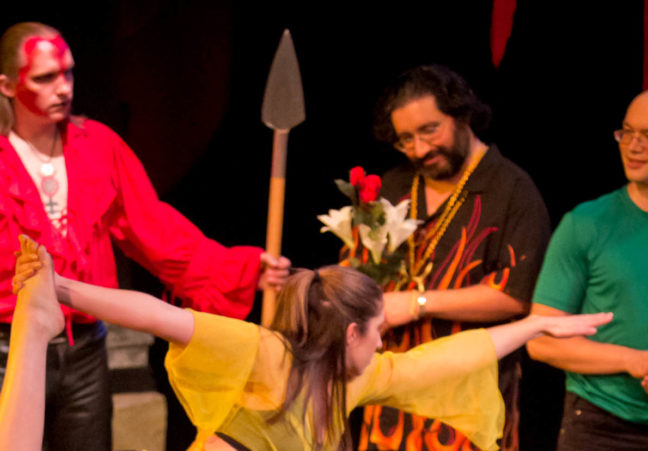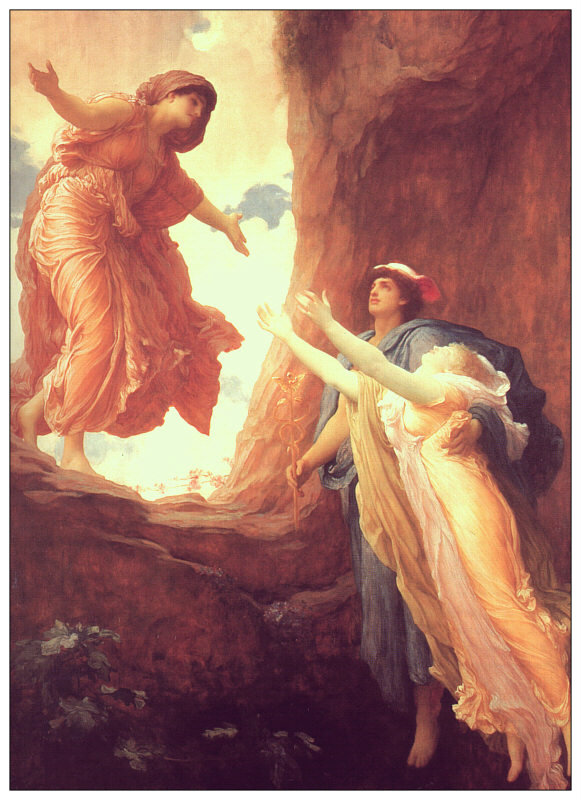Guest Blog Post by Marcos Duran
[Editor’s Note: Marcos Duran is a Seattle area artist and musician who has been gracious enough to work with us at Eleusyve Production starting in 2007 with The Rite of Venus. At our request today’s post is the story of how he developed one of our most interesting set pieces, the altar/hellbroth from The Rite of Saturn. Seeing as it features so prominently in the our first look video posted last Monday, it is fun to shed a little light on how it was done. In addition to props and set building, Marcos also appeared on stage for The Rite of Sol, and has regularly been integral to the entire production process, from attending planning meetings and adding his voice to the soundtrack, to providing playback for rehearsals, to being stage hand and musical instrument wrangler throughout the theatrical runs.]
Lighting the Hellbroth
Fire is expensive. You wouldn’t think to look at the stuff you can make fire with, nor how easy it is to set one, but fire is terribly expensive… at least if you’re trying to put it on a stage inside a building where more than two people are going to witness it. So.. ok.. Maybe not the fire itself. But the insurance you need for most venues to cover open flame on a stage is much more than a self-funded amateur theater company is going to have on hand. So… you have to improvise.
I’m Marcos Duran, prop-master for Eleusyve productions, and having participated in nearly all of the Eleusyve renditions of the Rites of Eleusis, I’ve come to learn a little something about fake fire. Over the years, we’ve employed various tricks and methods to approximate fire or flame like things. Even incense, which is still open flame, cannot be used, so we’ve managed our old favorite standby: dry ice and boiling water. We’ve used colored lights. But for our production of The Rite of Saturn, fire was going to play a center role in a lot of scenes and we needed to come up with something more interesting.
Fake fire in the theater world where there needs to be visible flame generally only takes a couple of forms. The first is fan-blown dyed silks that are lit from below. With the proper weight of silk fabric and the right colors of dyes and lights, this effect is actually pretty decent. The silks wave and ripple in the fans and make for a pretty good prop. The only problem is that fans make noise, and when you’re recording your audio live from the stage, any extraneous sounds, especially if they would mask dialog or singing in any way, are right out.
Digging around, I stumbled on a different technique that I also found out has commercial backing. It turns out that when you blow a diffuse water vapor mist through a set of appropriate colored lights, the reflection of that light through the mist and as it tapers off into the air make an impressive demonstration of believable flames. A great source for fine water vapor is an ultrasonic humidifier, and they generate the volume of mist needed without any noticeable sound. This technique is used commercially for no-fire fireplace inserts as well as large fire-like effects indoors for casinos and other large installations.
Here is an example of the effect:
I found a video of a prop guy building out a version of this kind of fake fire, and I decided to work with his techniques to build our own fire altar.
I picked up a test humidifier, and with a combination of tubing and some LED christmas lights, I was able to see the effect on a very small scale, so I knew if we could ramp it up, we might have something.
Here is what that test looked like:
The YouTube video included plumbing out two separate humidifiers to create enough mist to make a decent size faux fire, so I picked up another humidifier and some PVC piping and fittings along with a chunk of flexible marine tubing. The builder in the video used theater lighting cans to light the mist, and I didn’t have those available to me at the time of testing, but I picked up some strip LED lighting to attempt to build a lighting rig. Once I was able to collect mist from two humidifiers set at their highest level, I was able to get enough pressure to create the flow we needed.
To diffuse the mist, I took a straight length of piping, just like in the video, and drilled holes at short intervals along one line. This worked ok for a short time, but it was apparent that there were going to be some challenges. Water vapor would condense at the holes in the pipe, and over time due to the water surface tension, a droplet would form and completely block the hole. I tried a few techniques to see if I could find a way to lower the surface tension so this would stop, but what ultimately happened was that I created larger openings that took the form of slots instead of holes. This allowed the vapor to escape and it allowed the condensation to collect in a way that did not impact the pressure of the vapor. Another issue that came up was the fact that the diffuser tube was just too narrow to allow the vapor to spread well, so instead, larger diameter tubing and fittings were arranged and the slots were once again cut into the tube. This combination allowed us to get a fairly large and directed cloud of mist.
Lighting this cloud became a different challenge. The LED strip lights were definitely not bright enough. The light needed to be bright enough to reach high into the vapor cloud, so I began searching for alternatives. I stuck with LED mostly for safety. The cooler temperatures ensured that we wouldn’t have to get creative with cooling or other heat-related considerations when deciding on how to color the lights or how to enclose this assembly. I found two 3-light spotlight style lighting fixtures such that you would use in a living space to highlight a wall or a piece of art, and configured them with 600 lumen LED spot lights. I put one fixture on each side of the diffuser tube, inverted and angled so that the light would hit the wall of mist from underneath and at a focal point of about 2 feet above the deck. One of the advantages of focusing the lights this way was to also provide stage lighting on actors who were performing around the fire altar. As they approached the fire altar, they would glow and light up as though from the light of a real fire. It was a neat effect!
Lighting color became an important piece. If you use the wrong color gels, the effect does not look like natural fire. I did experiment for the sake of “science” with some alternatives, and it is possible to do some really interesting effects that are fire-like but very definitely not natural.
Here is what it looks like with red gels. A nifty effect, but definitely not natural!
The original reference YouTube video suggested that a mix of yellow and orange gels work best and that red is not advised. In my case, I discovered that the color temperature of my LED spot lights was cold enough that the yellow gels didn’t offer much to the effect, so I went strictly with an orange colored gel that I ended up doubling to increase the color saturation.
Rigging the gels was one of the most fiddly parts of the rig because I did not have a good pre-built solution. I ended up building a wire framework to hold the gels over the bulbs. It is the one piece of the puzzle that I will eventually rebuild if I bring out this prop again.
We ended up housing all of the equipment inside one of the base units from our old, well-painted friends, the obelisks. These are the sames obelisks that have enjoyed a role in nearly all of the Eleusyve Rites of Eleusis productions. The base offered plenty of room for all the equipment and gave us a structure for our fire altar. One of the face panels of the base was removed to allow access to the equipment, and a deck was made to cover the top except for about a 4 inch wide slot that ran the length of the middle from where the mist would escape. The mist rose and the lighting seemed to be working, but we needed a little extra force on the mist, so a small personal fan was installed beneath the diffuser tube to blow the mist up and out. This addition made the difference! It didn’t add appreciable noise, and in testing we were able to get some impressive flame-like effects. All of this was routed into a power strip inside the obelisk, and an extension was run to our lighting relays so that the effect could be controlled from the board.
Here is the initial test of the fully assembled rig:
The one consideration in the design that did get missed was the need for supply air venting for the fan. This problem wasn’t noticed until we were in the theater space, the unit installed, and the equipment hatch closed up. The fan had no source to pull in air and lost pressure, and as a result, the flames were not very high. I spent most of the production run battling this issue with various solutions including cutting holes into the floor of our set in order to provide the necessary venting. Thankfully, we figured it out in the end!
All in all, the piece had the desired effect, and we had amazing fire on stage! All this for around $100 plus the enclosure. It was relatively easy to build, and mostly easy to maintain. Adding it to the lighting relays, we were able to turn it on and off at will, and that added to the mystery of it.
Final look before installation in the theater:
This was a fun build, and it was extremely well received! I would highly recommend this as a great solution to bringing a larger fire to your stage production. It will keep your insurance agency and your pocketbooks at bay.


